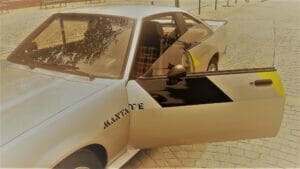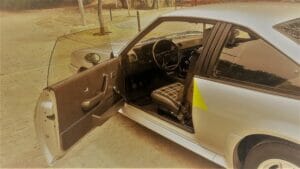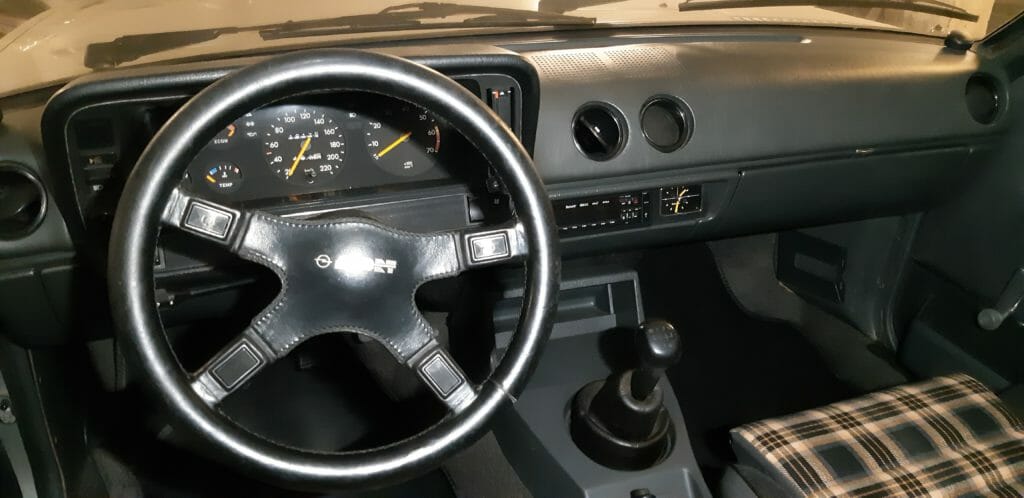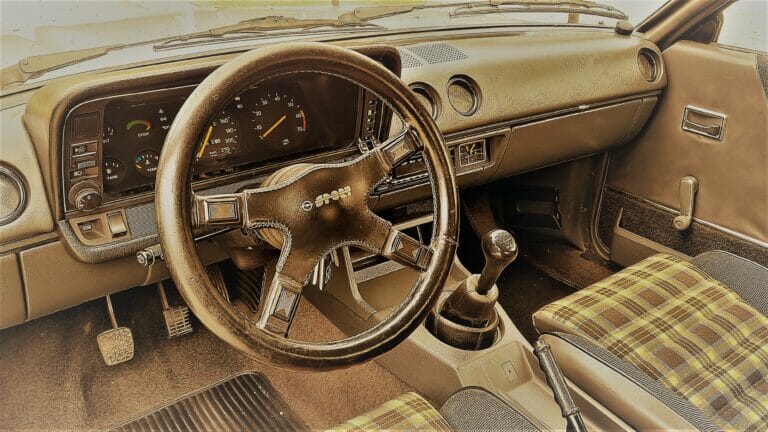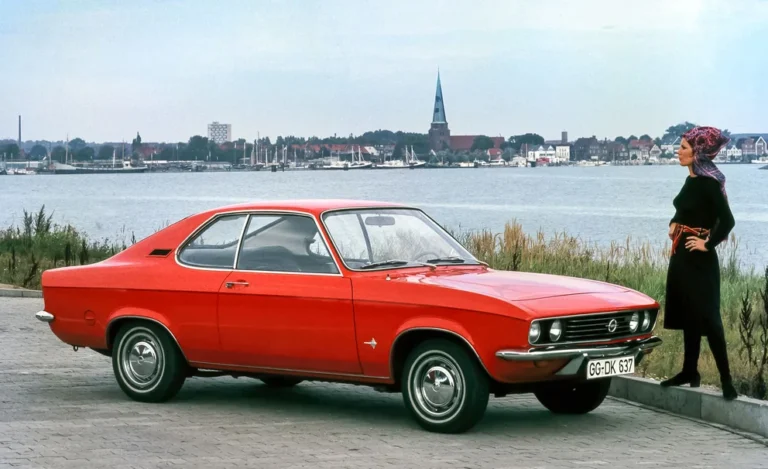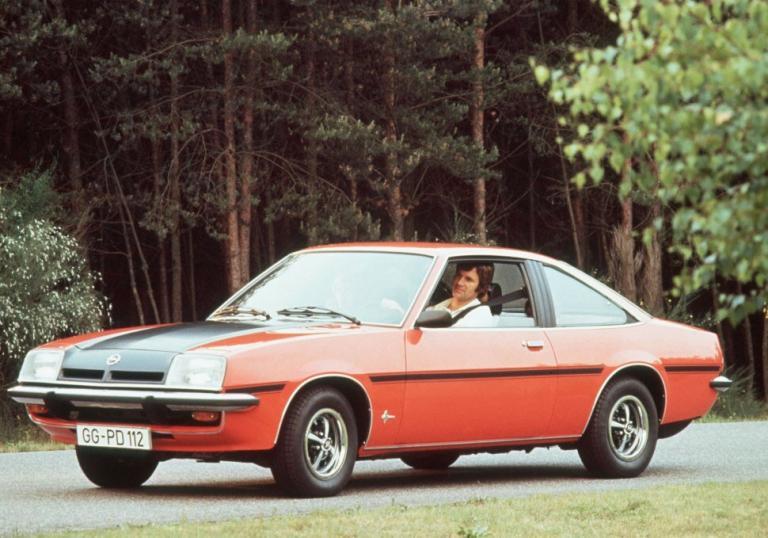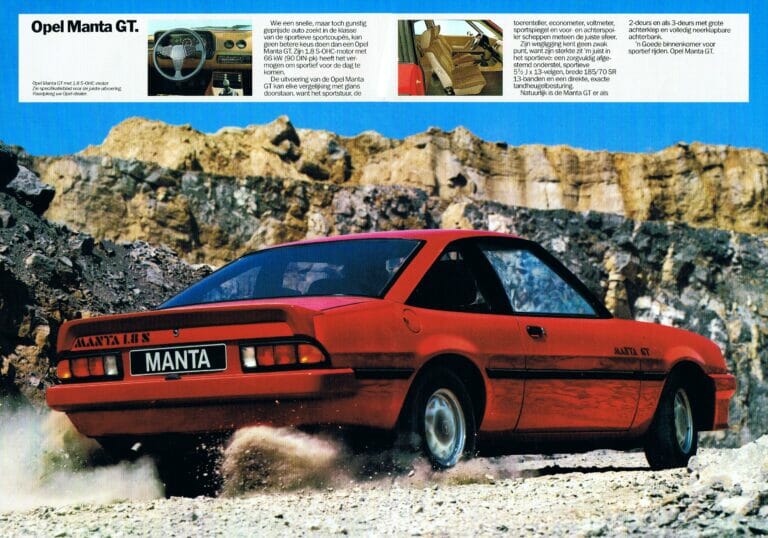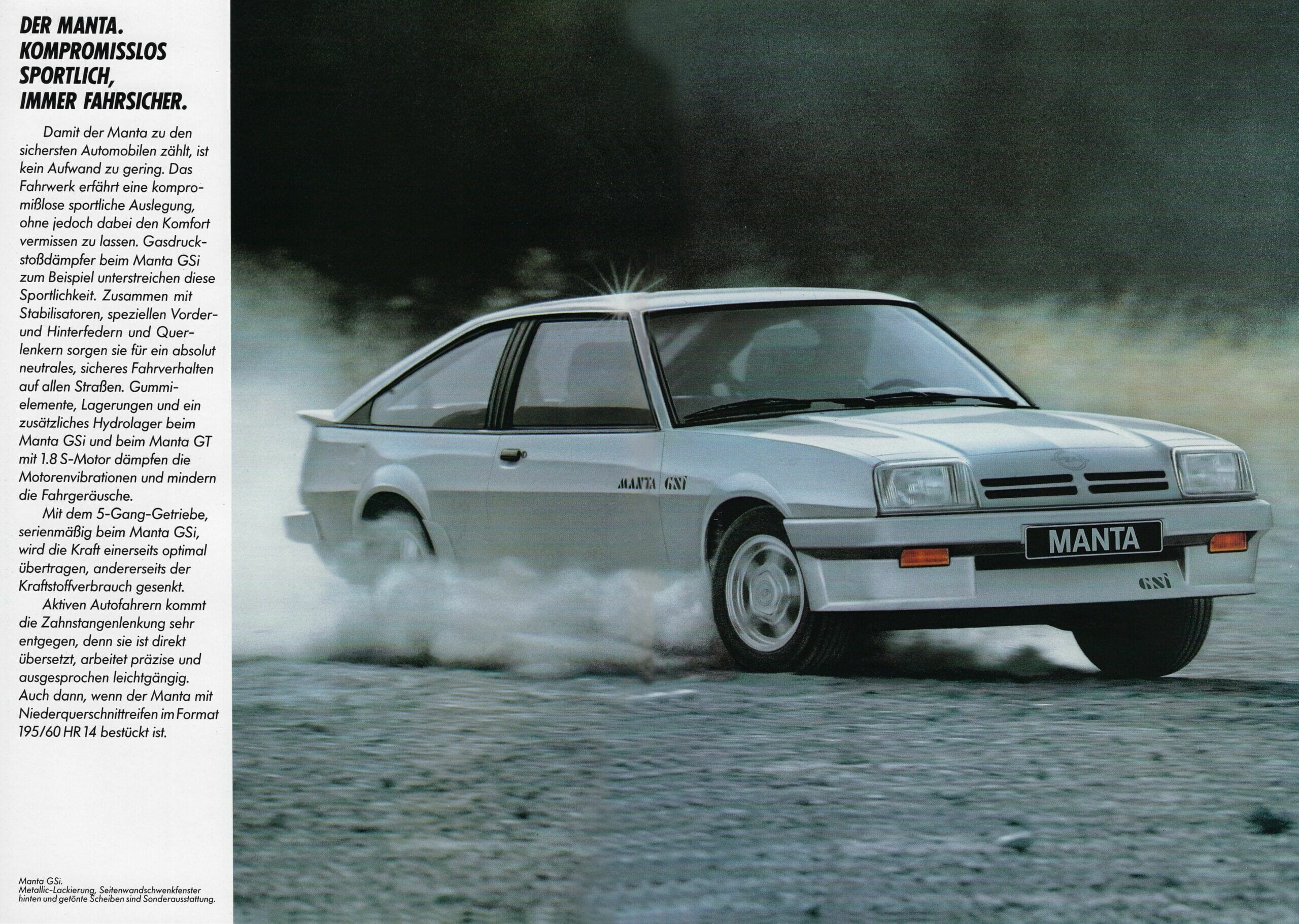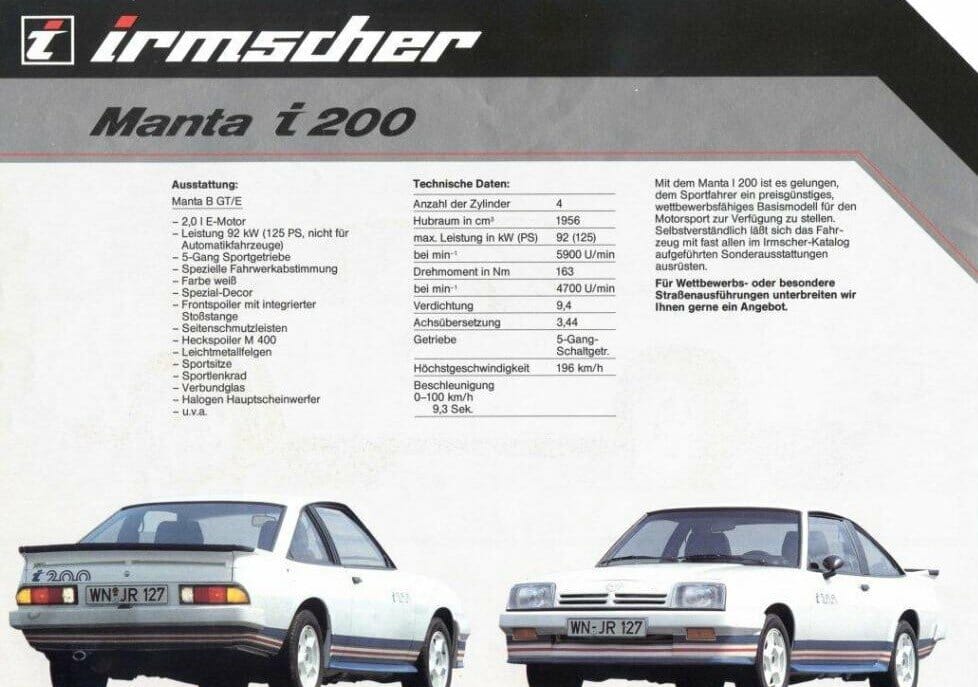Inicio » Our vehicles » Opel Manta GTE
Share in:
OPEL Manta GT/E
Origin: Barcelona, Spain, 1984
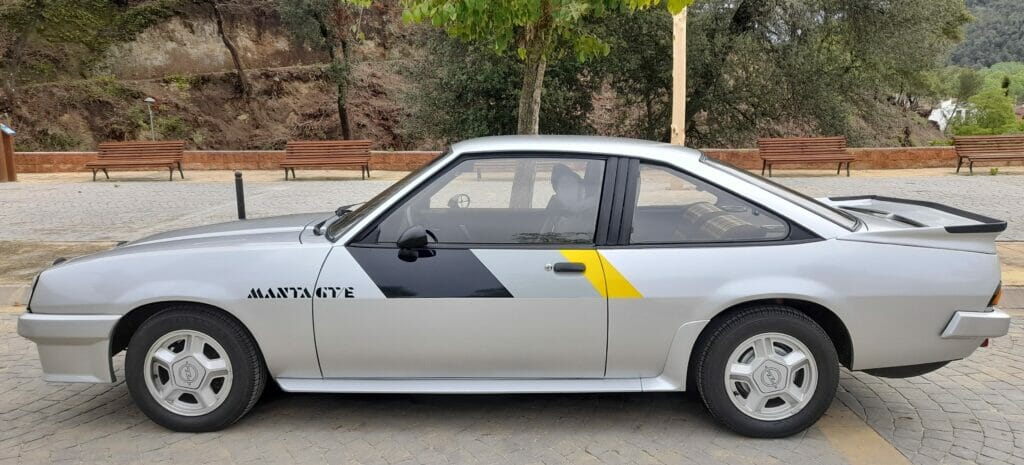
This is an Opel Manta B2 GT/E manufactured at the Antwerp plant in Belgium. This vehicle was manufactured in 1983 and registered in Barcelona in 1984.
It is powered by Opel’s 2.0 CIH(Cam in Head) engine – overhead camshaft – displacing 1979cc and delivering 110 hp at 5400 rpm.
In 2009, the car was repainted and repainted from its original silver color (reference Opel 128 86L Astro Silver). Although it is a GT/E, it carries two elements from the Opel Manta i200: the Irsmscher rear spoiler and the four-spoke leather-trimmed steering wheel.
We acquired this car in the first quarter of 2010. With us it has had basically two maintenance/reconditioning interventions – I do not use the term “restoration” because in this case it is not applicable -: the first one for disassembly/defacing and cleaning of upholstery and the second one for a preventive mechanical intervention in which we did:
- Preventive change of the water pump (it did not fail, but it is known that after years they fail, so it is better to change it before it shows symptoms).
- Radiator repair at Radiadores Soler (it is copper radiator so it is always repairable/rebuildable).
- Change of the viscous fan clutch.
- Change of the service belts.
- Replace engine silent blocks.
- Replacement of clutch kit (press, disc and bearing) and clutch cable.
- Brakes: Change of calipers, cylinders, pump, discs and drums.
From 2009 onwards, we do not know the history of this vehicle – apart from knowing that it had several owners – but we believe that in general it had a “quiet” life. And we believe that, because apart from the fact that there was no need for mechanical interventions other than maintenance due to normal wear and tear, we could see that (when we acquired it and now), that the engine turns with good regularity, there is no visible oil consumption, the oil comes out very clean during changes, and the coolant is always clear and without deposits. If we consider that we are talking about a 40-year-old vehicle that is completely standard, the diagnosis is more than satisfactory.
This vehicle is currently in circulation and available for available for rent if you need it if you need it for a photo shoot, filming or exhibition. In any case, please feel free to contact us if you have any vehicle-related needs so we can help you.
Also, if you are an owner or future buyer of one of these models and you need any information about parts, spare parts, or technical information you may need, please contact us because we will be happy to share it with you.
Opel Manta GT/E. Photo album. Click on the category:
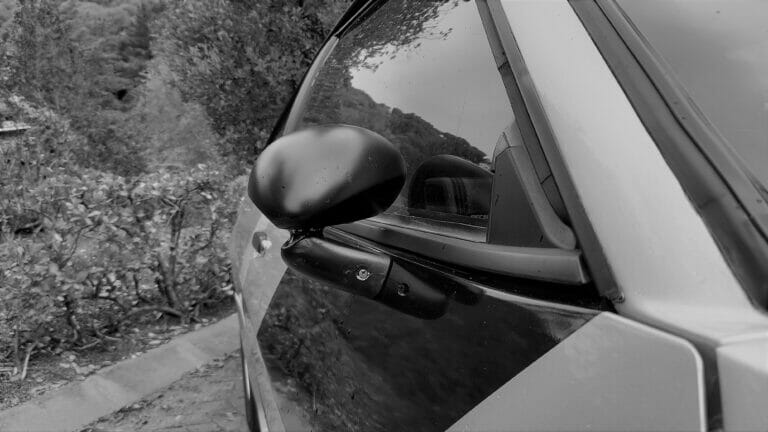
Opel Manta - History
Update March 2025: We have prepared an article about the history of the Opel Manta from a social and cultural point of view. If you are an enthusiast of the model, you will like it. We encourage you to watch it by clicking this button:
The Opel Manta was created in 1970, designed on the basis of the Opel Ascona of the time. There were two generations of Opel Manta, known as Opel Manta A (1970-1975) and Opel Manta B (1975-1988), of which there were in turn two families, Opel Manta B and Opel Manta B2.
All models of all generations were front longitudinal engine and rear-wheel drive. There were different engines throughout its history, from 1200CC carbureted to 2000CC Bosch L-Jetronic electronic injection. Throughout its life, units were also available with a 4 or 5-speed manual gearbox (depending on the version) or a three-speed automatic gearbox.
Although the Opel Ascona, on which it was based, switched to a transverse engine and front-wheel drive in the Ascona C, the Manta retained its original front longitudinal engine and rear-wheel drive design (CIH engine, “Cam in Head” with the camshaft on one side of the valves and the valves driven by tappets and rocker arms without pushrods) until the end.
The first version of Opel Manta, (Opel Manta A), conceived as a competitor to the Ford Capri, round pilots and a more “classic coupe” shape would last until 1975 when it was replaced by the Opel Manta B originally based on the Chevrolet Monza. This “B” version of the Opel Manta was modified in 1982, update in which the plastic bumpers/spoilers were incorporated into the bodywork, as well as a rear spoiler that would give it a more modernized look by the standards of the time, as well as a more aggressive and/or sporty line.
Opel Manta: industrial coupes - From sports car to classic through an anachronistic phase
The Opel Manta belongs to that category informally known as “industrial coupe”: those vehicles of generalist brands that, starting from a chassis of a sedan or a compact, manufacturers transformed into a model with a sporty look and coupe body (or at least two doors) with some improvements in its engine and mechanics in general, but with no extreme performance and a relatively affordable price. They were obviously not vehicles that could compete -but actually they were not pretending to- with the traditional sports cars of the big premium brands. However they had their audience and they became part of the memory of many of those in their twenties in the 80s as that kind of car in which many of them dreamed of owning. In the case of the Opel Manta, Opel sold it as a product in which it emphasized sportiness and its striking – spectacular for some, excessive for others – lines.
These industrial coupes in particular – and the Opel Manta was no exception – after their heyday, went through a phase in which they were seen as outdated and anachronistic antiques rather than classics. The Anglo-Saxons use the expression “crock or classic?” to refer to this duality. During this period they experienced a period of devaluation and many of the units of the time underwent some of the most “imaginative” transformations and tunnings by some of their owners. Over time, those that have survived, have already earned the classification of classics in their own right, quite possibly because the passage of time has meant that only units in good condition or restored in a manner equal or reasonably similar to their original state have remained.
In Spain, the Opel Manta marketed from 1982 were the models of Manta B GT/E (Injection L-Jetronic, 110 hp) and GSI later, which had the same mechanical and exterior of the GT/E, changing just some details such as the color of the upholstery, tinted glass in other shades (green instead of bronze) or the typography of the characters of the clocks of the box.
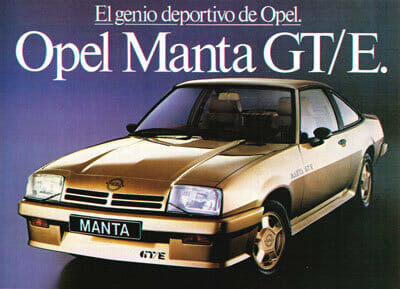
The top of the range model that could be purchased “as standard” was the Opel Manta i200, which with the same engine as the Opel Manta GT/E in terms of displacement, gave a little more power: 125hp – instead of the 110hp of the GT/E – achieved with a lowered cylinder head and a different camshaft design, although the design of the engine meant that it had to be driven high to take advantage of its performance. The “i” in the model name corresponds to the name of “Irsmsher”, a German car preparation company with a traditional relationship with Opel GM. About 700 units of this i200 model were produced, making it a highly sought-after model among enthusiasts.
Opel Manta: Special versions: TurboManta, i240, i300, i400
Turbomanta: In 1973, almost a prototype. Created on the basis of the 1.9S (carburation) engine of the Manta A. Only 33 units were manufactured by a company called Broadspeed on behalf of General Motors, which went from the 90hp of the original engine to 156hp (although with the penalty of a very high consumption).
Manta i240: Based on the Manta B GT/E between 1984 and 1986. 2400CC engine, 134CV, 200Kms/h top speed. 300 units produced. External appearance similar to the finish of the Manta i400
Manta i300: Prepared by Irmscher. Longitudinal 3000CC 6-cylinder engine, the same as the Opel Monza or Opel Senator. 174hp, 225 km/h top speed.
Manta i400: Originally conceived as an exclusive version of the Manta GT/E. There were actually two phases of the Manta i400:
- The first phase of the i400 in which the engine delivered 143hp, in an engine powered by the Bosch LE Jetronic system (power and ignition controlled by the electronic control unit), had 7×15-inch Ronal wheels and upholstery and steering wheel finishes similar to the i200 and with bodywork finishes similar to those of the i200 (and even more sober than those of the i200).
- The second phase was a phase 2, in which, with the aim of taking it to the competition, important changes were made to the bodywork (Kevlar and carbon fiber panels, as well as the fins and bumpers characteristic of the i400), to the wheels (8×15″ Ronal wheels at the front and 10×15″ at the rear), and above all to the mechanics, with a 4-cylinder engine prepared by Cossworth. This engine was a 4-cylinder with carburetors that originally provided 230 hp, although in preparations it delivered 270 hp, 300 hp and up to 340 hp. Of the Manta i400 245 units were manufactured (at least 200 were necessary to homologate it in competition for Group B). In 1984 Carlos Sainz came to participate in the Rallie de Catalunya, although the truth is that the Manta i400 came too late and soon became obsolete in the competition by the entry of turbos and 4×4. Be that as it may, the Group B ban left all of them out of the competition.
The Opel Manta was discontinued in 1988 after having sold just over one million units, of which approximately half corresponded to the Opel Manta A and the other half to the Opel Manta B.
Opel Manta: The i200 steering wheel. Not Irmscher or Opel
The Opel Manta i200 steering wheel: It is not an Opel or Irmscher steering wheel – if you want to buy one, look for it under “Italvolanti”.
One of the most appreciated parts among Opel Manta fans is the i200 (or i400) steering wheel. This is a 4-spoke steering wheel, upholstered in leather and somewhat smaller than the one on the Manta GT/E. Many of the fans would like to have one. Well: This steering wheel is not from Opel, even if it has its logo in the center, but it was manufactured by the Italian company called “ITALVOLANTI”. If you search the Internet for “ITALVOLANTI” references, you will find this and similar models, and even some of them, with the adaptation of the handle exactly the same as the Manta i200. Here you can find examples taken at random from units for sale (as of June 2023) belonging to two Volkswagen and Mercedes vehicles respectively.
Opel Manta Electric: RestoMOD 2021
A couple of years ago, in 2021, Opel GM showed a “concept car” based on the Manta A body, called “Opel Manta GSE” electric drive. This model provides 147hp, rear-wheel drive, a “classic” gearbox like that of combustion cars. The weight distribution has been taken care of by installing the engine at the front and the batteries at the rear in order to maintain a reasonable 50-50% weight distribution.
The car has been shown by Opel on the occasion of the celebration of the 50th anniversary of the Opel Manta, as a restyling, or RestoMOD using the currently fashionable term for converting some classic models to new technologies, but maintaining their original appearance. According to those who have been able to test it, this new Opel Manta covers quite well the expectations of what a fan of the model could expect, resulting in a fun vehicle to drive, and that despite its electrification does not abandon its essence, nor a large part of the sensations it produces to its driver when -inevitably- it is compared with its original namesake of the 70s.
There are some voices or articles that mention 2025 as the date of mass production, but this does not seem very likely, and it is not (at the moment, as of June 2023) in any way assured: apart from commercial and financial issues – it does not seem that this is a model from which a very high volume of sales could be expected – the vehicle would have to pass some redesigns, such as the fact that the battery occupies the entire trunk, as well as crash tests and other homologations. So the only certainty for the moment -June 2023- is that Opel has shown a concept car, capable of rolling -this one- on public roads, but still far from having assured its entry into the assembly lines.
Here are some videos about the model: they are in English and German, but if you don’t know either language, you can use the subtitled version with translation.

